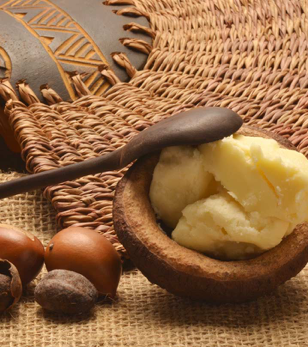What Is Shea Butter?
go.ncsu.edu/readext?657376
en Español / em Português
El inglés es el idioma de control de esta página. En la medida en que haya algún conflicto entre la traducción al inglés y la traducción, el inglés prevalece.
Al hacer clic en el enlace de traducción se activa un servicio de traducción gratuito para convertir la página al español. Al igual que con cualquier traducción por Internet, la conversión no es sensible al contexto y puede que no traduzca el texto en su significado original. NC State Extension no garantiza la exactitud del texto traducido. Por favor, tenga en cuenta que algunas aplicaciones y/o servicios pueden no funcionar como se espera cuando se traducen.
Português
Inglês é o idioma de controle desta página. Na medida que haja algum conflito entre o texto original em Inglês e a tradução, o Inglês prevalece.
Ao clicar no link de tradução, um serviço gratuito de tradução será ativado para converter a página para o Português. Como em qualquer tradução pela internet, a conversão não é sensivel ao contexto e pode não ocorrer a tradução para o significado orginal. O serviço de Extensão da Carolina do Norte (NC State Extension) não garante a exatidão do texto traduzido. Por favor, observe que algumas funções ou serviços podem não funcionar como esperado após a tradução.
English
English is the controlling language of this page. To the extent there is any conflict between the English text and the translation, English controls.
Clicking on the translation link activates a free translation service to convert the page to Spanish. As with any Internet translation, the conversion is not context-sensitive and may not translate the text to its original meaning. NC State Extension does not guarantee the accuracy of the translated text. Please note that some applications and/or services may not function as expected when translated.
Collapse ▲What is Shea butter? Shea butter is the fat that is extracted from the nuts of shea trees. Even in warm temperatures, it is ivory to white in color and solid in form. The Shea trees are native to West Africa. Most of the pure shea butter that we buy still comes from this region.
Shea butter has been used for centuries. The high concentration of fatty acids and vitamins make it easy to spread as an ingredient in cosmetics designed to smooth and condition the skin.
Although shea butter comes from a tree nut, it is different than most tree nuts. It is very low in the proteins that can produce allergies.
Shea butter can be used on all skin types. Natural shea butter does not contain chemicals that dry out the skin. The fatty acid content of shea butter consists of linoleic, oleic, stearic, and palmitic acids. Theses oils absorb into the skin quickly, creating moisture and restoring lipids. Shea butter, applied on the skin, creates a barrier between skin and the environment.
Although shea butter is a wonderful moisturizer for all skin types, the American Academy of Dermatology agrees with the idea that shea butter can clog pores and cause acne, if you have acne-prone skin.





